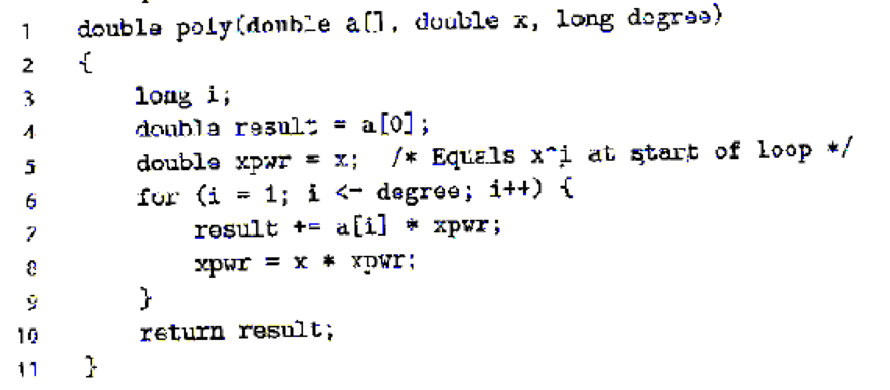
Practice Problem 5.5 (solution page 575)
Suppose we wish to write a function to evaluate I polynomial where a polynomial of degree n is defined to have a set of coefficients a0, a1 a2 ….an. For a value x. we evaluate the polynomial by computing
(5.2) a() + a1x + a2x2 + + anxn (5.2)
This evaluation can be implemented by the following function, having as arguments an array of coefficients a, a value x, and the polynomial degree degree (the value n in Equation 5.2). In this function, we compute both the successive terms of the equation and the successive powers of x within a single loop:

- A. For degree n, how many additions and how many multiplications does this code perform?
- B. On our reference machine, with arithmetic operations having the latencies shown in Figure 5.12, we measure the CPE for this function to be 5.00. Explain how this CPE arises based on the data dependencies formed between iterations due to the operations implementing lines 7-8 of the function.

Figure 5.12 Latency, issue time, and capacity characteristics of reference machine operations. Latency indicates the total number of clock cycles required to perform the actual operations, while issue time indicates the minimum number of cycles between two independent operations. The capacity indicates how many of these operations can be issued simultaneously. The times for division depend on the data values.
Want to see the full answer?
Check out a sample textbook solution
Chapter 5 Solutions
Computer Systems: A Programmer's Perspective (3rd Edition)
Additional Engineering Textbook Solutions
Modern Database Management
Digital Fundamentals (11th Edition)
Concepts of Programming Languages (11th Edition)
Starting Out with C++: Early Objects
Database Concepts (7th Edition)
- 4 We consider the following initial value problem for two functions y(x),z(x): 0=y′′+(y′+6y)cos(z), 5z′=x^2+y^2+z^2, where 0≤x≤2 and y(0)=1.7, y′(0)=−2.7, z(0)=0.5. Approximate the solution of this initial value problem using Euler's method with 100 steps. (use Maple) What approximation value do you obtain for y(2) and z(1)?arrow_forward5. (a) Write a function that solves the general linear least-squares problem. The inputs to your function should be a vector of a values, a vector of measured y values, and an anonymous function that calculates a single row of the Z matrix. Inside your function, use the inputted anonymous function to create Z row-by-row, then use Z to create the normal equations. Solve these normal equations to obtain the computed coefficients that define the best-fit of your model. Your function should output these calculated coefficients. Again, include an error check that makes sure the input vectors are the same size. You may not use any built-in MATLAB functions to solve the normal equation. You can use any functions you have developed solves Ax = b via LU-decomposition is one option. e.g. a function you have that (b) Test your function in (a) to fit the following model to the given dataset (see belo y = a + bx (c) Test your function in (a) to fit the following model to the given dataset…arrow_forwardQ.) Do given c and d problem belowarrow_forward
- PROBLEM 12. [TIME ALLOWED = 5 MINUTES] Give the contrapositive and converse of the following proposition: “If it is sunny, then I will go swimming.”arrow_forwardPROVIDE PYTHON CODE Determine the drag coefficient needed so that an 80-kg parachutist has a velocity of 36 m/safter 4s of free fall.Note: The acceleration of gravity is 9.8m/s2. Start with initial guesses of xl = 0.1 and xu = 0.2 and iterate until the approximationrelative error falls below 2 % in pythonarrow_forward3. Simplify the following Boolean functions, using four-variable Kmaps: (a) F (w, x, y, z) = Σ(1, 4, 5, 6, 12, 14, 15) (b) F (A, B, C, D) = Σ(2, 3, 6, 7, 12, 13, 14) (c) F (w, x, y, z) = Σ(1, 3, 4, 5, 6, 7, 9, 11, 13, 15)arrow_forward
- (Practice) a. To convert inches (in) to feet (ft), the number of inches should be multiplied by which of the following conversion factors? i. 12 in/1 ft ii. 1 ft/12 in b. To convert feet (ft) to meters (m), the number of feet should be multiplied by which of the following conversion factors? i. 1 m/3.28 ft ii. 3.28 ft/1 m c. To convert sq.yd to sq.ft, the number of sq.yd should be multiplied by which of the following conversion factors? i. 1 sq.yd/9 sq.ft ii. 9 sq.ft/1 sq.yd d. To convert meters (m) to kilometers (km), the number of meters should be multiplied by which of the following conversion factors? i. 1000 m/1 km ii. 1 km/1000 m e. To convert sq.in to sq.ft, the number of sq.in should be multiplied by which of the following conversion factors? i. 144 sq.in/1 sq.ft ii. 1 sq.ft/144 sq.in f. To convert minutes (min) to seconds (sec), the number of minutes should be multiplied by which of the following conversion factors? i. 60 sec/1 min ii. 1 min/60 sec g. To convert seconds (sec) to minutes (min), the number of seconds should be multiplied by which of the following conversion factors? i. 60 sec/1 min ii. 1 min/60 secarrow_forwardShow complete solution please. I am at a loss of how to even begin this problem and would like to learn how to work through each step.arrow_forwardPROBLEM 13. [TIME ALLOWED = 5 MINUTES] Give the contrapositive, converse, and inverse of the following proposition: “If the number is positive, then its square is positive.”arrow_forward
- Question 3 In 12–17, use the IVT to verify each function has a root in the given interval(s). Then use the Bisection Algorithm to narrow the location of that root to an interval of length less than or equal to 0.1. f(x) = x^2 − 2 on [0, 3] Full explain this question and text typing work only thanksarrow_forwardC++ I need simple solution for this example in 20 minutesarrow_forwardPlease help me solve Part A of this problemarrow_forward
 C++ for Engineers and ScientistsComputer ScienceISBN:9781133187844Author:Bronson, Gary J.Publisher:Course Technology Ptr
C++ for Engineers and ScientistsComputer ScienceISBN:9781133187844Author:Bronson, Gary J.Publisher:Course Technology Ptr
